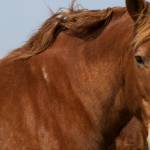Thyroid Hormones May Benefit Metabolic Horses

The thyroid hormones triiodothyronine and thyroxine, known also as T3 and T4, take part in essentially all metabolic pathways in a horse’s body. From promoting oxygen consumption to regulating synthesis of various proteins, controlling body heat production to stimulating metabolism, thyroid hormones do it all. No wonder thyroid supplements such as levothyroxine sodium have garnered a popular spot on the shelves of many feed rooms.
“Hypothyroidism, characterized by low circulating thyroid levels, is rarely observed in horses,” shared Kathleen Crandell, Ph.D., a nutritionist for Kentucky Equine Research. “In fact, horses that have undergone surgical removal of the thyroid gland show very few clinical signs associated with hypothyroidism that are often noted in other species. Usually, only cold intolerance and hair coat abnormalities such as coarse hair, mild hair loss, or delayed shedding occur.”
According to a group of veterinary researchers from Australia and the United States, the occurrence of hypothyroidism in adult horses remains questionable. Those experts suggest that horses suspected of having hypothyroidism could actually have equine metabolic syndrome (EMS) instead. Commonly reported signs associated with EMS include weight gain, low fertility, and altered fat metabolism, all of which are clinical signs attributable to hypothyroidism in humans and dogs.
In horses, management of EMS revolves around dietary restriction and exercise to promote weight loss and dietary modification to minimize elevations in blood insulin levels after consumption of sugary meals. Often, exercise proves challenging if the affected horses have laminitis, and many EMS horses are easy keepers and therefore resistant to weight loss.
“Because levothyroxine supplementation is inexpensive and reportedly facilitates weight loss, even in horses with normal thyroid glands, there is an interest in exploring the use of this product in EMS horses,” said Crandell.
While research in this field continues, Crandell recommends, “Stick to the tried-and-true recommendations for managing EMS.” These include:
- Weight loss at a rate of 0.5 and 1.0% of body mass per week achieved by offering a forage-based ration totaling 1.4-1.7% body weight daily.
- Such forage should contain <10% nonstructural carbohydrates to limit increases in blood insulin. Forage analysis and hay-soaking will likely be required to achieve this goal;
- Avoid feeding grains or cereal-based feeds, fruits, or vegetables, such as carrots, apples, or other treats, as well as high-fat feeds; and
- Supplement the diet with a ration balancer or a vitamin/mineral supplement to ensure the horse receives vital nutrients.
“Kentucky Equine Research offers Micro-Max, a low-intake, concentrated source of vitamins and minerals for mature horses, particularly those on diets composed entirely of forage or forage and small amounts of concentrate,” advised Crandell. Australian horse owners should look for other research-proven options available.
*Bertin, F.R., L. Eichstadt Forsythe, and J.E. Kritchevsky. 2019. Effects of high doses of levothyroxine sodium on serum concentrations of triiodothyronine and thyroxine in horses. American Journal of Veterinary Research. 80(6):565-571.








